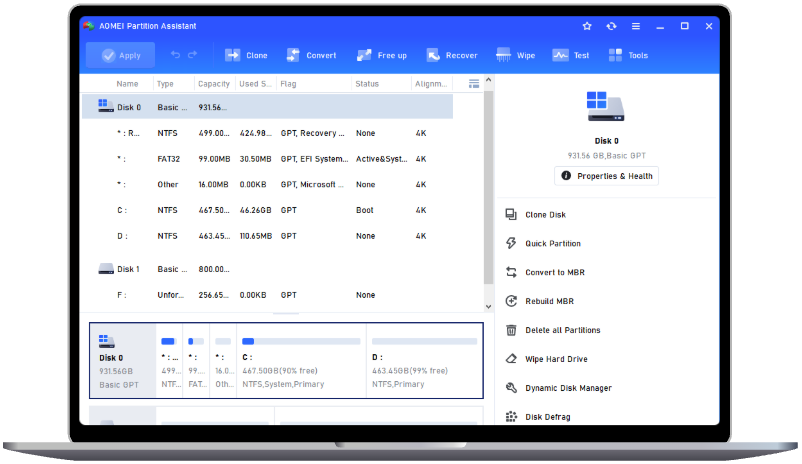How to Fix Disk Showing as Raw Instead of NTFS [ 2 Ways]
Why is my disk showing as RAW instead of NTFS? This article provides two feasible solutions to fix it. That is to convert a RAW drive back to the NTFS file system.
Why is my disk showing as RAW instead of NTFS?
If your disk is showing as RAW instead of NTFS, it means the file system on the drive is not recognized or is corrupted. Here are several possible reasons why this might be happening:
1. Corrupted file system
A corrupted file system can occur due to improper shutdowns, system crashes, or power failures. When the file system becomes corrupted, Windows may not be able to recognize it and will show the disk as RAW.
2. Drive letter or partition issues
Sometimes, the drive letter or the partition may get lost or unassigned, making it show as RAW. This can be fixed by reassigning a drive letter or rebuilding the partition.
3. Formatting errors
If the disk was recently formatted, but the process didn't complete correctly, it could result in a RAW file system. For example, using a tool to format the drive and accidentally selecting the wrong file system can cause this issue.
4. Faulty or failing hard drive
A physical issue with the hard drive, such as bad sectors or hardware failure, can lead to file system corruption, causing the disk to be recognized as RAW.
5. Accidental disk conversion
You might have accidentally converted the drive to an unrecognized file system (like FAT or exFAT) and then formatted it to RAW. Sometimes, trying to recover data from a RAW drive can lead to this issue.
The good news is that you can fix this problem! In the next section, we'll walk you through the steps to recover your drive and prevent it from showing as "RAW". Keep reading for the solution!
2 ways to fix disk showing as RAW instead of NTFS
If your disk is showing as RAW instead of NTFS, it typically means the file system is corrupted or damaged. Here are two ways to fix this issue:
Way 1. Use CHKDSK
CHKDSK is a built-in Windows utility that checks and repairs disk issues, including file system errors. Here's how to use it:
Step 1. Open the Command Prompt with administrative privileges. To do this, press Windows + X and select Command Prompt (Admin) or Windows PowerShell (Admin).
Step 2. Type the following command and press Enter:
chkdsk C: /f (Replace Cwith the letter of the RAW disk)
Step 3. Wait for the process to complete. If the disk is repairable, CHKDSK will fix the errors and attempt to restore the file system to NTFS.
Note: This method works if the file system is damaged, but the data is still intact. However, it doesn't guarantee success if the disk is severely corrupted.
Way 2. Format the disk (data loss)
If CHKDSK doesn't work or you can't recover the disk with the first method, you can format the disk to restore it to NTFS. Keep in mind that formatting will erase all data on the disk, so only do this if you don't need the existing data or have already backed it up.
Step 1. Open Disk Management by pressing Windows + X and selecting Disk Management.
Step 2.Right-click on the RAW disk and select Format.
Step 3. Choose NTFS as the file system and set the desired allocation unit size.
Step 4. Click OK to start the formatting process. Once completed, the disk will be restored to NTFS.
Note: If you need to recover data before formatting, consider using data recovery software or consulting a professional service to retrieve your files.
Formatting a disk through Command Prompt can be intimidating, especially for those unfamiliar with command-line interfaces. That’s where AOMEI Partition Assistant comes in — a powerful and intuitive disk management tool designed to make complex operations simple for everyone.
With AOMEI Partition Assistant, you can format internal and external hard drives, USB flash drives, and SD cards with just a few clicks — no need to remember complicated commands or risk formatting the wrong drive.
Step 1. Install and launch the program, right-click the RAW file system pen drive that you’re planning to format, and hit the Format Partition.
Step 2. Choose NTFS as the File System of pen drive, press OK.
Step 3. Press Apply at the left upper corner and Proceed to format RAW pen drive to NTFS/FAT32.
These methods should help resolve the issue of a disk showing as RAW instead of NTFS.
Conclusion
If your disk showing as RAW instead of NTFS, it usually means the file system is damaged or unreadable. This can be caused by corruption, partition issues, failed formatting, or hardware failure. You can try repairing it using CHKDSK or reformatting the drive, though formatting will erase all data. For a safer and easier approach, tools like AOMEI Partition Assistant simplify the process with user-friendly features.


